Understanding Qualcomm's Snapdragon 810: Performance Preview
by Joshua Ho & Andrei Frumusanu on February 12, 2015 9:00 AM EST- Posted in
- SoCs
- Qualcomm
- Mobile
- Gobi
- Snapdragon 810
GPU Performance
Last but certainly not least, we have GPU performance. As we mentioned earlier, the Snapdragon 810 introduces Qualcomm's Adreno 430, the latest member of the Adreno 400 GPU family. Qualcomm's own performance estimates call for a 30% increase over Adreno 420, with a final GPU clock of 600MHz being identical to the Snapdragon 805's (Adreno 420) own GPU clock speed.
From an architectural standpoint Adreno continues to be something of a black box for us. Other than being a modern OpenGL ES 3.1/AEP design, we don't know too much about how the GPU is laid out, and Qualcomm's current legal battle with NVIDIA likely not helping matters. In any case, Qualcomm has indicated that Adreno 430 is not just a simple extension of Adreno 420, so we may be looking at an architectural change such as wider shader blocks.
For today's benchmarks, as we mentioned before we only had a limited amount of time with the Snapdragon 810 and had issues with BaseMark X. We've had to pare down our GPU benchmarks to just 3DMark 1.2 and GFXBench 3.0. Once we get final hardware in, we will be able to run a wider array of graphics benchmarks on Snapdragon 810.
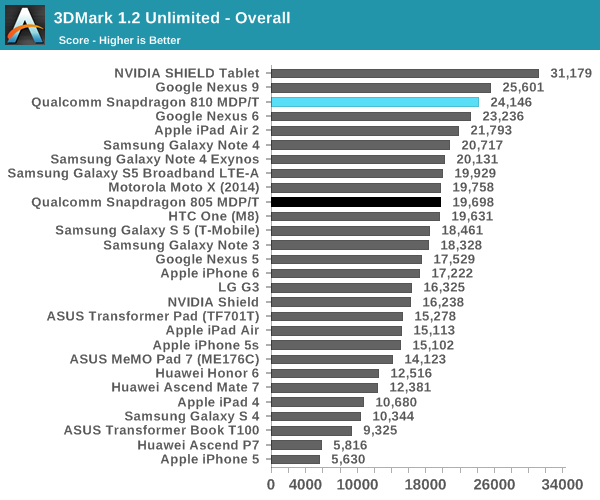
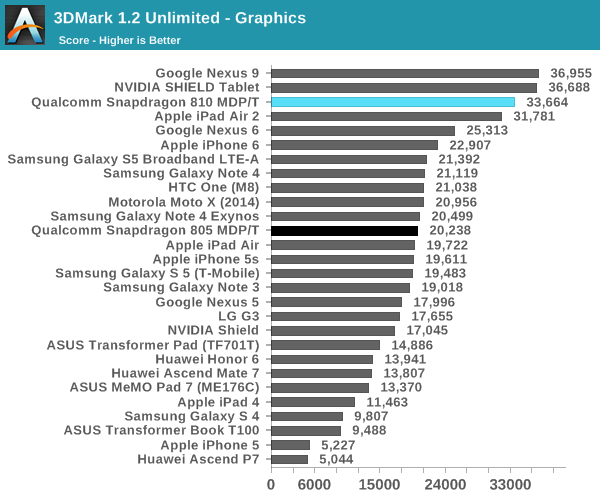
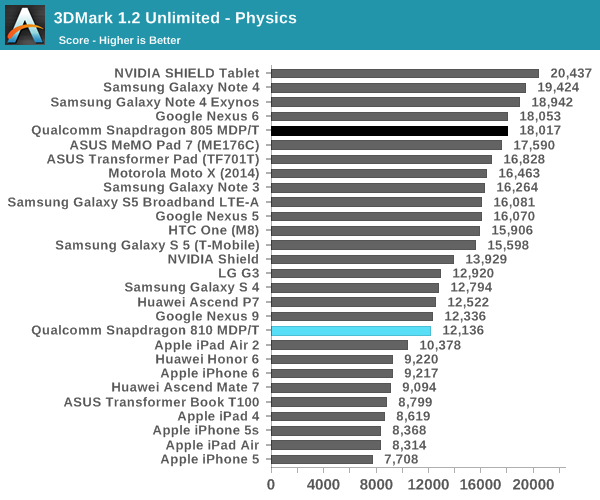
Starting off with 3DMark, compared to the Snapdragon 805 reference platform the actual graphics performance advantage is even greater than 30%, coming in at closer to 65%. However since drivers play a big role in this, a more recent 805 platform like the Nexus 6 may be a better comparison point, in which case the gains are 33%, just a hair over Qualcomm's own baseline performance estimate. We also find that Snapdragon 810 oddly struggles at physics performance here, underperforming Snapdragon 805 devices, something the Exynos 5433 didn't have trouble with. As a result overall performance is only slightly improved over the Nexus 6.
Continuing with GFXBench, we look at more pure GPU loads. One has to take note that the MDP/T employs a 4K screen resolution, and the on-screen results will likely suffer from that.

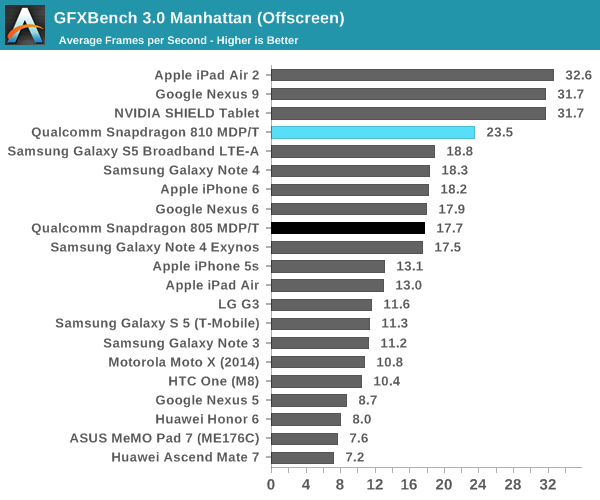
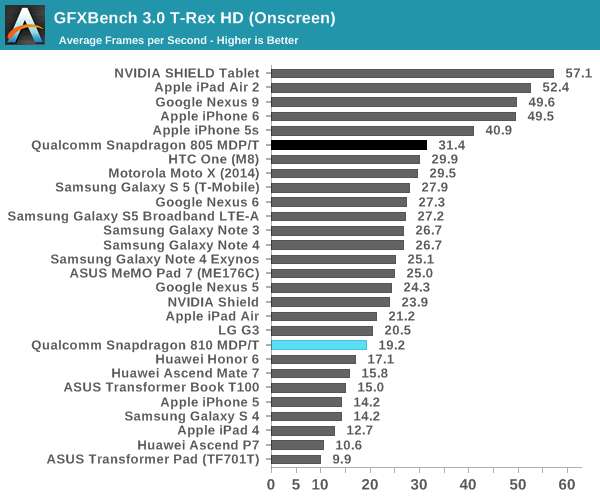
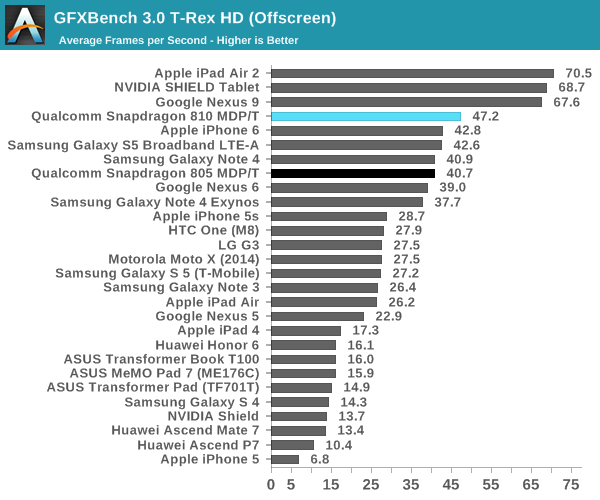
Under GFXBench 3.0's full rendering tests of Manhattan and T-Rex, the Snapdragon 810 continues to show considerable performance gains over the Snapdragon 805. Ignoring the onscreen results for now since the Snapdragon 810 reference platform runs at such a high resolution, offscreen results show the 810 outperforming the 805 by 33% in Manhattan and 16% in T-Rex. The former is again well in-line with Qualcomm's performance estimate, wile the older T-Rex benchmark doesn't show the same gains, possibly indicating that Adreno 430's biggest gains are going to come from shader-bound scenarios.
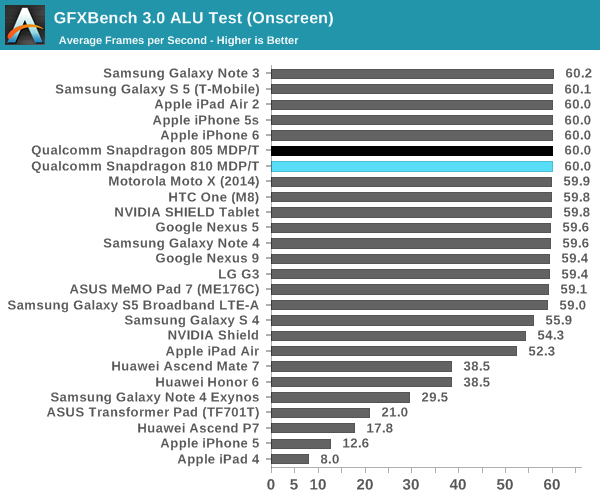
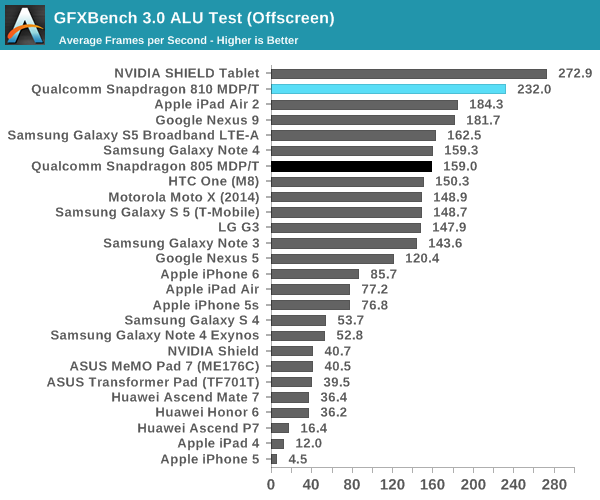

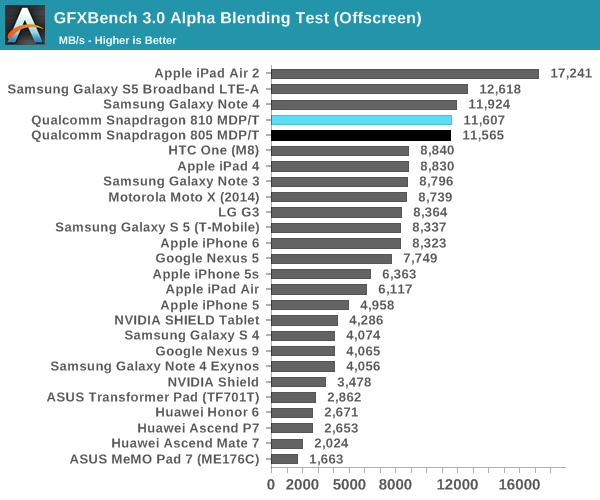
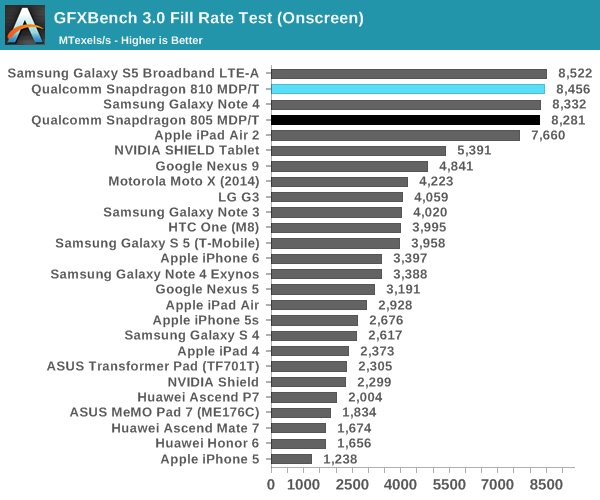
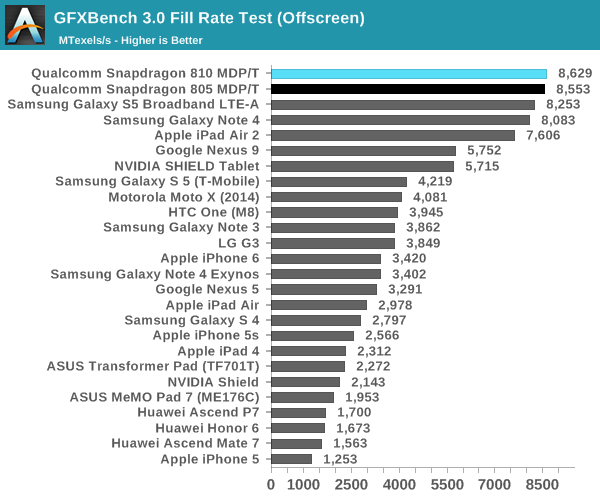
Meanwhile GFXBench's synthetic tests continue to put Adreno 430 and the Snapdragon 810 in a good light. ALU performance in particular is showing very large gains - 46% better than the Snapdragon 805 and Adreno 420 - while our blending and fillrate tests show almost no gain over Snapdragon 805. This adds further credence to our theory that Qualcomm has widened or otherwise improved Adreno's shader blocks for 430, as other elements of the GPU are not showing significant performance changes.
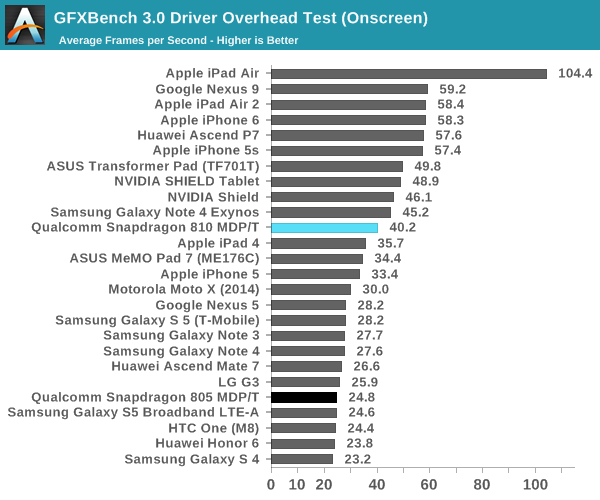
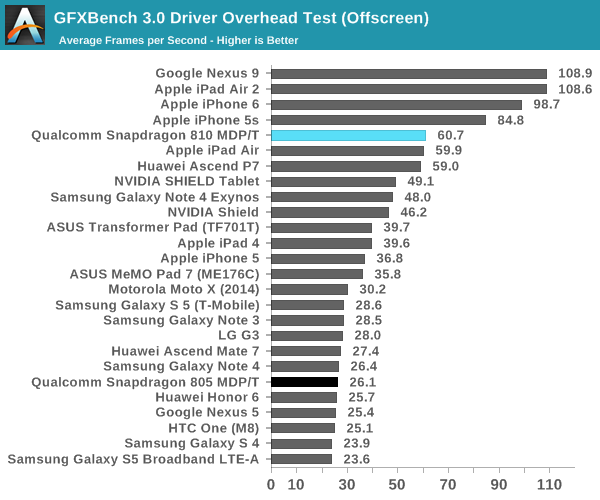
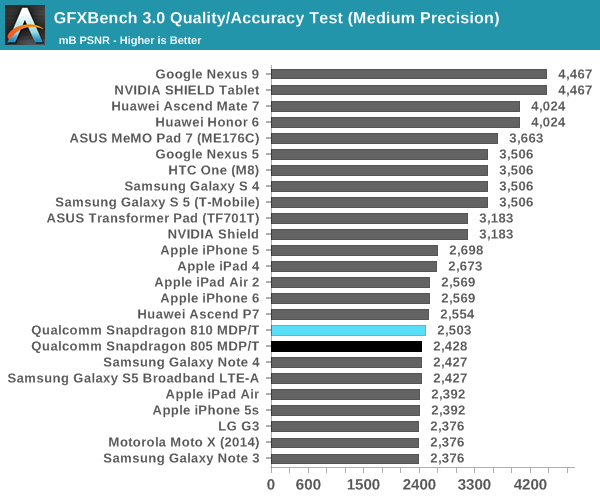

Finally, GFXBench's driver overhead and accuracy tests are more or less what we would expect for Snapdragon 810. In the case of driver overhead, a combination of newer drivers and a much faster CPU have reduced the CPU cost of driver overhead. Meanwhile with the underlying GPU architecture being unchanged, there are no material changes to quality/accuracy.
Overall then the performance gains for the Adreno 430 and Snapdragon 810 seem to be almost exclusively focused on shader performance, but in those cases where rendering workloads are shader bound, Qualcomm's 30% estimate is on the mark. Real-word performance gains meanwhile are going to depend on the nature of the workload; games and applications that are similarly shader-bound should see good performance gains, while anything that's bottlenecked by pixel throughput, texturing, or front-end performance will see much smaller gains. Thankfully for Qualcomm most high-end workloads are indeed shader bound, and this is especially the case when pushing high resolutions, as Qualcomm is trying to do with their 4K initiative for Snapdragon 810. However in the case of 4K, while Adreno 430 offers improved performance it's still slow enough that it's going to struggle to render any kind of decently complex content at that resolution.
As for Adreno 430 versus the competition, Qualcomm has narrowed much of the gap between themselves and NVIDIA/Apple, but they haven't closed it. Apple's Imagination GX6850 and NVIDIA's K1 GPUs continue to hold a performance advantage, particularly in GFXBench's Manhattan and T-Rex full rendering tests. Both Apple and NVIDIA invested significant die space in graphics, and while we don't know how much Qualcomm has invested in Adreno 430 with Snapdragon 810, it's safe to say right now that they would need to invest even more if they want to beat the graphics performance of NVIDIA and Apple's tablet SoCs.










119 Comments
View All Comments
aryonoco - Friday, February 13, 2015 - link
Yes, that sentence is totally meaningless.JoshHo - Sunday, February 15, 2015 - link
I didn't write the Geekbench analysis, I'm currently looking into the issue.randymorrisplano - Friday, February 13, 2015 - link
You guys who say 2 or 4k is too much for anything under 6" displays, are seriously are not taking the near future of ubiquitous VR on our handsets. Putting the display that close to the eyes, with magnifying optics, makes it a whole new ballgame.Gigaplex - Friday, February 13, 2015 - link
If I was going to do that, I'd use a VR headset, rather than holding my phone over my eyes.68k - Friday, February 13, 2015 - link
Interesting that Aarch32 get slightly better integer score in Geekbench compared to Aarch64. The lack of HW support for AES and SHA-1 in earlier Aarch32 capable CPUs and the fact that earlier 32 vs 64-bit comparisons has not been done on the same CPU-uarch made it tricky to directly compare results between Aarch32 and Aarch64.Adjusting for the difference in clock frequency between Exynos 5433 and Snapdragon 810, Aarch32 is about 12% fast. Removing the AES result which is an outlier in favor for Exynos, the performance lead for Aarch32 is still about 5%.
Aarch64 seem to do better in the MT cases compared to ST cases, the average lead for Aarch in all ST cases with AES removed is 16%.
dragonsqrrl - Friday, February 13, 2015 - link
So many awesome reviews and previews from Anandtech in the past week. Keep up the good work!lilmoe - Friday, February 13, 2015 - link
At this point of software optimization, I still believe big.LITTLE Core Migration is the way to go. Software isn't yet up to task for GTS, most of that complexity should be handled by hardware.fivefeet8 - Friday, February 13, 2015 - link
Your GFXbench3.0 driver overhead benchmarks seems to be off for the Shield Tablet. Unless maybe Android 5.x is causing a degradation there.sonicmerlin - Friday, February 13, 2015 - link
So how many bands will this new modem be able to support? And why do Apple phones always seem to support more LTE bands than the competition?aryonoco - Friday, February 13, 2015 - link
1) Depends on how many filters and transceivers the OEM fits the phone with. The baseband makes it easier to support more but the actual band support would still be OEM dependant.2) Because Apple does not shy away from high BoM and can cram as much filters and transceivers as they want in order to reduce the number of SKUs. Android manufacturers (unfortunately) don't think like that.